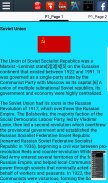








History of the Soviet Union

توضیحات History of the Soviet Union
The Union of Soviet Socialist Republics[b] (USSR),[c] commonly known as the Soviet Union,[d] was a socialist state in Eurasia that existed from 30 December 1922 to 26 December 1991.[9] Nominally a union of multiple national Soviet republics,[e] its government and economy were highly centralized. The country was a one-party state, governed by the Communist Party with Moscow as its capital in its largest republic, the Russian Soviet Federative Socialist Republic (Russian SFSR). Other major urban centres were Leningrad, Kiev, Minsk, Alma-Ata, and Novosibirsk.
Extending across the entirety of Northern Asia and much of Eastern Europe, the Soviet Union had spanned eleven time zones and incorporated a wide range of environments and landforms. From northwest to southeast, the Soviet Union shared land borders with Norway, Finland, Poland, Czechoslovakia, Hungary, Romania, Turkey, Iran, Afghanistan, China, Mongolia, and North Korea. It shared its maritime borders with Japan by the Sea of Okhotsk and the US state of Alaska across the Bering Strait. With an area of 22,402,200 square kilometres (8,649,500 sq mi), the Soviet Union was the largest country in the world by area, covering more than one-eighth of the Earth's inhabited land area,[10][11][12] and the third most populous, with over 288 million people as of 1989, with 80% of the population living in the western, European part of the country.
The Soviet Union had its roots in the October Revolution of 1917, when the Bolsheviks led by Vladimir Lenin overthrew the Russian Provisional Government which had replaced Tsar Nicholas II during World War I. In 1922, the Soviet Union was formed by the Treaty on the Creation of the USSR which legalized the unification of the Russian, Transcaucasian, Ukrainian and Byelorussian republics that had occurred from 1918. Following Lenin's death in 1924 and a brief power struggle, Joseph Stalin came to power in the mid-1920s. Stalin committed the state's ideology to Marxism–Leninism (which he created) and constructed a command economy which led to a period of rapid industrialization and collectivization. During this period of totalitarian rule, political paranoia fermented and the late-1930s Great Purge removed Stalin's opponents within and outside of the party via arbitrary arrests and persecutions of many people, resulting in over 600,000 deaths.[13] Suppression of political critics and forced labor were carried out by Stalin's government. In 1933, a major famine that became known as the Holodomor in Soviet Ukraine struck multiple Soviet grain-growing regions, causing the deaths of some 3 to 7 million people.[14]
In August 1939, days before the start of World War II, the Soviets signed the Molotov–Ribbentrop Pact agreeing to non-aggression with Germany, after which the two countries invaded Poland in September 1939. In June 1941, the pact collapsed as Germany turned to attack the Soviet Union, opening the largest and bloodiest theatre of war in history. Soviet war casualties accounted for the highest proportion of the conflict in the effort of acquiring the upper hand over Axis forces at intense battles such as Stalingrad and Kursk. The territories overtaken by the Red Army became satellite states of the Soviet Union and the postwar division of Europe into capitalist and communist halves would lead to increased tensions with the West, led by the United States of America.
اتحادیه جمهوریهای سوسیالیست شوروی (ب) (اتحاد جماهیر شوروی)، [c] که معمولا به عنوان اتحاد جماهیر شوروی شناخته می شد، یک دولت سوسیالیست در اوراسیا بود که از دسامبر 1922 تا دسامبر سال 1991 وجود داشت. [9] به طور اساسی اتحاد شوروی چندین شوروی، دولت و اقتصاد آن بسیار متمرکز بودند. این کشور یک حزب یک حزب بود که توسط حزب کمونیست با مسکو به عنوان پایتخت آن در بزرگترین جمهوری خود یعنی جمهوری فدرال سوسیالیست اتحاد جماهیر شوروی روسیه (SFSR روسیه) اداره می شد. سایر مراکز عمده شهری عبارت بودند از لنینگراد، کیف، مینسک، آلما آتا و نووسیبیرسک.
اتحاد جماهیر شوروی در سراسر شمال آسیا و بسیاری از اروپای شرقی گسترش یافت و یازده منطقه زمانی را پوشانده بود و طیف گسترده ای از محیط ها و شکل های زمین را تشکیل می داد. از شمال غرب تا جنوب شرقی، اتحاد شوروی مرزهای مرزی با نروژ، فنلاند، لهستان، چکسلواکی، مجارستان، رومانی، ترکیه، ایران، افغانستان، چین، مغولستان و کره شمالی را در اختیار داشت. مرز دریایی خود را با ژاپن توسط دریای اوکوتسک و ایالت آلاسکا در سراسر تنگه برینگ به اشتراک گذاشت. اتحادیه اتحاد جماهیر شوروی با مساحت 22،402،200 کیلومتر مربع (8،649،500 مایل مربع)، بزرگترین کشور جهان در منطقه است، که بیش از یک هشتم از زمین های ساکن زمین را پوشش می دهد، [10] [11] [12] و سومین جمعیت پرجمعیت، با بیش از 288 میلیون نفر از سال 1989، با 80 درصد از جمعیت در غرب، بخش اروپا از کشور زندگی می کنند.
اتحاد جماهیر شوروی ریشه در انقلاب اکتبر 1917 داشت، زمانی که بلشویکها به رهبری ولادیمیر لنین، دولت حکومت روسیه را که در طول جنگ جهانی اول جایگزین تزار نیکلاس دوم شد، سرنگون کردند. در سال 1922، اتحاد جماهیر شوروی توسط پیمان خلقت تشکیل شد از اتحاد جماهیر شوروی سابق که اتحاد اتحاد جماهیر شوروی روسیه، ترككوكایی، اوکراین و بلاروس را كه از سال 1918 به وقوع پیوست، قانونی كردند. بعد از مرگ لنین در سال 1924 و مبارزه كوتاه مدت، ژوزف استالین در اواسط دهه 1920 به قدرت رسید. استالین ایدئولوژی ایالت را به مارکسیسم-لنینیسم (که او آن را ایجاد کرد) متعهد کرد و یک اقتصاد فرماندهی ایجاد کرد که منجر به یک دوره صنعتی سازی سریع و جمع آوری شد. در طول این دوران حکومت توتالیتر، پارانوای سیاسی تخمیر شد و در اواخر دهه 1930، "بزرگ دفع"، مخالفان استالین را در داخل و خارج از حزب از طریق دستگیری های خودسرانه و آزار و اذیت بسیاری از مردم، به بیش از 600،000 مرگ منجر کردند. [13] سرکوب منتقدان سیاسی و کار اجباری توسط دولت استالین انجام شد. در سال 1933 یک قحطی بزرگ که به عنوان "هولودومور" در اتحاد جماهیر شوروی شناخته شد، مناطق چند گانه روستایی شوروی روبرو شد و باعث مرگ 3 تا 7 میلیون نفر شد. [14]
در ماه اوت سال 1939، روزهای قبل از شروع جنگ جهانی دوم، شوروی ها پیمان مولوتوف-ریوبنتروپ را به توافق برساند که بدون تجاوز با آلمان باشد، پس از آن دو کشور در سپتامبر 1939 به لهستان حمله کردند. در ماه ژوئن 1941 این پیمان به عنوان آلمان تبدیل شد برای حمله به اتحاد جماهیر شوروی، باز کردن بزرگترین و خونین ترین تئاتر جنگ در تاریخ. تلفات جنگی اتحاد جماهیر شوروی بیشترین میزان درگیری را در تلاش برای دستیابی به نیروهای محور در جنگ های شدید مانند استالینگراد و کورسک به وجود آورد. سرزمین های تحت فرماندهی ارتش سرخ تبدیل به کشورهای ماهواره ای اتحاد جماهیر شوروی شد و بخش تقسیم اروپا پس از جنگ به نیمه های سرمایه داری و کمونیست منجر به افزایش تنش ها با غرب به رهبری ایالات متحده آمریکا شد.

























